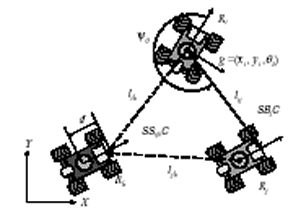 |
|
||||
| Cooperative Control and Localization of Multiple Robots |
|
|
Introduction In
real world situations multi-agent robotic systems are subject to sensor,
actuator and communication constraints, and have to operate within uncertain
or unstructured environments. We are interested in tasks that include
exploration, surveillance, search and rescue operations, mapping of
unknown or partially known environments, and distributed manipulation
and transportation of large objects. In all these applications,
there is a need to |
 |
Objective Using a team of wheeled robots equipped with omnidirectional cameras and an IEEE 802.11b wireless network, this project develops a leader-follower paradigm which allows the team to maintain a particular formation while it is in motion. In this project, a follower uses the state of its leader to compute its control signals such that predefined separations and orientations are maintained. The behavior of such systems can be analyzed using the theory of interconnected systems. A set of graph-based algorithms are developed to enable the robots to perform the following tasks:
The final demonstration will consist of having the team of robots maintain a predefined formation while moving towards a target location. |
|

